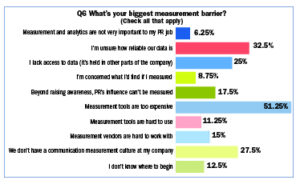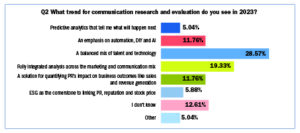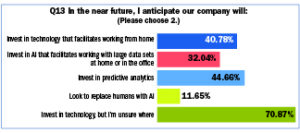
It’s Communication Measurement Month 2022 and the U.S. is in an inflationary period. On top of that, some observers anticipate recession in 2023. In both scenarios, scrutiny over business spending should increase.
With the anticipated challenging macroeconomic environment in 2023, “business leaders…in every industry are being asked to demonstrate their value. And PR leaders are no different,” says Nigel Glennie, SVP, global communications, Ecolab.
Yet our annual Measurement Month survey (120 respondents, fielded online Oct. 11-26, 2022) shows few differences from results in our 2021 poll. Both surveys contain reasons for optimism about communication measurement and analytics, as well as concerns for its health. This dichotomy spurred much discussion.
Uncertainty and Measurement
It’s notable that both surveys were fielded at uncertain moments. In 2021, COVID’s influence was ebbing, yet concerns lingered about the economy and the future of work.
Johna Burke, CEO, AMEC, the International Association for the Measurement & Evaluation of Communication, thinks emphasizing uncertainty is misplaced. “You always have some uncertainty,” she says.
More important, Burke argues, is that data can help companies overcome uncertainty.
That said, this year’s survey includes these measurement findings:
-
Economic uncertainty has 43% of PR pros saying they’re relying on data more than previously and 43% saying they’re doing so about as much as they did before.
-
89% say they measure earned, paid and owned media “all,” “most” or some of the time.
-
93% see measurement and analytics as an “advantage,” with 74% of them saying it helps “find useful operational insights.”
-
Yet 69% of those surveyed insist there are “barriers to measurement.”51% say “tools are too expensive.”
-
37% said PR-related tech investment at their companies will “increase modestly,” 41% said it will remain flat, 70% anticipate tech investment, but are “unsure” where.
-
Just 5% of new graduates “know” communication measurement “well.”
The workplace questions in the survey found:
-
84% say PR pros will depart their jobs if employers “don’t offer flexible hours/WFH.”
-
60% say PR pros will leave if compensation isn’t increased “significantly.”
-
Beyond mental health and safety, top factors for PR pros’ job satisfaction are: increased salary/bonus (53%) and flexible hours (43%).
-
Nearly 60% of respondents must come to the office for “some amount of time”.
-
32% say colleagues have “quietly quit.”
Commenting on Chart 1, Katie Paine, the self-styled queen of measurement and Paine Publishing founder, is “not at all surprised” that 43% of PR pros say they are using data more now. A looming recession and uncertainty “from inflation, war and elections has senior leadership demanding data before making decisions,” she says. The figure was 40% last year. At that time we asked if COVID's withering of the economy prompted more reliance on data.
Paine adds, “I can’t tell you how many people I’ve talked to in the last six months who have been given very clear marching orders: ‘Measure or else!’”
This is especially so when tech platforms like Proof and Converseon show the revenue increase “that communication can deliver.” PR can’t “get away with saying, ‘It’s intangible’ anymore,” Paine says.
Mark Weiner, chief insights officer, PublicRelay and PRNEWS measurement columnist, and Burke find the responses unsurprising, yet they have doubts. This is what people know they’re supposed to say, Burke argues.
Weiner agrees. He says many PR pros espouse the virtues of measurement and data, “but then they continue to do things the same old way,” often avoiding measurement and data.
Measurement Confusion
 This line of argument bleeds into our interviewees’ concern about what seems to be communication measurement’s mixed bag. Nearly all PR pros say measurement and analytics provide advantages (Chart 7). As Glennie says, “There’s only one right answer and I’m glad the overwhelming majority of PR pros know it.”
This line of argument bleeds into our interviewees’ concern about what seems to be communication measurement’s mixed bag. Nearly all PR pros say measurement and analytics provide advantages (Chart 7). As Glennie says, “There’s only one right answer and I’m glad the overwhelming majority of PR pros know it.”
Yet almost 70% report contending with measurement roadblocks (Chart 5), ranging from expensive tools and unreliable data to the lack of a measurement culture (Chart 6). It was 69% in our 2021 survey.
Is it likely that such positive and negative attitudes toward measurement exist in our survey respondents? For Burke, the answer is no. “It seems mind-boggling to me,” she says. Adds Weiner, “If data is that big of an advantage, the barriers in Chart 6 should melt away.” Paine’s comment about barriers was direct: "B.S. Lame!"
(Paine also called B.S. on the 18% of respondents who said "beyond raising awareness, PR’s influence can’t be measured." Burke and Weiner agreed.)
 Burke, Paine and Weiner have theories that explain the unlikely dichotomy. PR pros' confusion about measurement is one. Another is that the survey wasn't clear enough.
Burke, Paine and Weiner have theories that explain the unlikely dichotomy. PR pros' confusion about measurement is one. Another is that the survey wasn't clear enough.
For example, Burke isn’t sure respondents were considering integrated PR data instead of just media relations data when they answered survey questions about data.
Unreliable Data or ?
Turning to the lack-of-reliable-data barrier, Burke says it exists “in large part because there is a lack of planning” when companies collect data and PR uses data it hasn’t collected directly. Moreover, “there's a lack of understanding about methodology and definitions that” other parts of the company use when collecting and referencing their data.
When a vendor collects data and you think it’s unreliable, Paine suggests “auditing the data…talk to your vendor about what doesn’t look right and get them to fix it.”
Our commenters had a lot to say about measurement barriers related to tools (51% of respondents said they’re too expensive and 11% said they’re too hard to use), vendors and the lack of a measurement culture in companies.
Tools Problems
Again, Burke questioned the survey’s definition of tools. “People can say tools are anything from a CRM system to press-release distribution to media monitoring, to high-end analysis.” Admittedly, some of those are expensive. Next year’s survey will include a more comprehensive definition of tools.
Yet Burke agrees with Paine and Weiner, who note the abundance of low-cost and free tools. “Everyone has a tool,” Weiner says. Adds Paine, it’s difficult to accept that “tools are too expensive” received 51% of the vote. Commercial email and social platforms “give you more data than you’ll ever use,” Paine says. “So, that barrier [to measurement] is made of pure fear or laziness.”
When a paid tool is too difficult to use, “you’re using the wrong tool,” Paine says. When tool vendors are difficult to work with, “get another vendor…notice how flexible they can be when” you mention you’re considering ending their contract.
Weiner argues sometimes tools aren’t the entire issue. PR pros need to learn “how to manage the tool and optimize the data to uncover actionable insights.” Spending more for technology “doesn’t achieve that…the answer goes back to…tools and talent…the category is so heavily commoditized that switching tools won’t always solve the problem. This is where talent is the operative word.”
On a lack of measurement culture, Burke called it "laughable...ask the CEO or CFO whether or not your company measures...corporations by nature measure everything...when PR isn't measuring sometimes it's because the lead communicator is avoiding measurement."
Indeed, Weiner mentions an incident when a PR leader told him: I don't want to measure because I'm concerned about what I'd find.
Integration and Measurement Trends
 Certain results in the trends question (Chart 2) were surprising. “Why isn’t ‘fully integrated analysis across the marketing and communication mix’ (19%) the top choice?” Paine asks. “I haven’t seen anyone say they want to measure just PR or just social.”
Certain results in the trends question (Chart 2) were surprising. “Why isn’t ‘fully integrated analysis across the marketing and communication mix’ (19%) the top choice?” Paine asks. “I haven’t seen anyone say they want to measure just PR or just social.”
She adds “everyone is building and using integrated dashboards that are bringing all forms of corporate communication together.” Frequently they’re adding marketing, advertising and CRM data, too.
An advocate for mixing people with technology, Weiner was happy seeing “talent and technology” receive the most support (28%).
On the other hand, he feels predictive analytics (5%) is “under-represented here. It’s still uncommon, but it’s very alluring for communicators and service providers alike. The key is data accuracy, and that’s very specialized.”
Paine believes predictive analytics are just now arriving on the scene, so “that number won’t increase for at least another year, if not two. The data is just not that credible yet.”
What is ESG?
Commenting on the ESG trend in this chart (6%), Weiner’s concerned. So many agencies claim expertise, “but I don’t think there are enough true experts to support the claim,” he says. “Some agency client will be burned badly by a failed ESG promise.”
AMEC’s Burke thinks use of the term ESG here is too broad. “Did respondents think of ESG as environmental issues only” or did they consider the S and G elements too?
Oil and Water, Numbers and PR
 The question about new communicators’ attitude and knowledge about measurement (Chart 4) stirred a lot of ire from those we interviewed.
The question about new communicators’ attitude and knowledge about measurement (Chart 4) stirred a lot of ire from those we interviewed.
Glennie says “it's disappointing that so many believe recent graduates went into PR to avoid working with numbers.” While PR work emphasizes words, “we must also be able to speak knowingly about who's listening, what words to use and the impact of those words,” he says. “We're doing…a disservice if we're not making sure” measurement “is part of their work experience.”
Weiner and Paine insist it’s not entirely an education issue. The better PR programs, they assert, teach measurement and data methods as part of applied research classes. “They definitely know the basics and frequently know much more about correlations and predictive analytics than their bosses,” says Paine, who lectures regularly at some dozen colleges yearly. In addition, she conducts measurement training for PR professors.
Weiner serves on an advisory board at the University of Florida School of Communications. The school offers “courses and practicums in communication measurement,” he says.
The Canard of PR and Numbers
Weiner adds, “The notion that ‘students get into PR to avoid numbers’ is a canard.” More likely it’s nobody goes into PR to operate tools. Unfortunately, “almost every first-year professional” will operate tools on the job. Graduates won’t experience the glamour of Samantha Jones from HBO’s “Sex in the City.” Instead, “they will be tool operators for several years.”
For Burke, “numbers aren’t a problem” for young PR pros; “it’s the math. Those are two different things.” For example, she says, Millennials and Gen Z “are the savviest generation” with numbers,” owing to their social media knowledge, which centers on numbers of followers.
On the other hand, History or English majors know little about data and measurement, Paine admits. “I wish statistics and applied research were required to graduate,” she says. “At the very least, they should be required before you can get a job in communication in 2023.”
Each year, we include questions gauging the temperature of PR beyond measurement. As you saw in the chart at the head of this story, we found 84% of respondents put increased salaries, WFH and flexible hours as their top concerns  (Chart 9).
(Chart 9).
Glennie and 15 others didn’t respond to this question. He notes the survey question was too negative. We will improve it next time. “At least in my case, I am optimistic about our profession and the increasingly important role we play at senior levels of organizations,” Glennie says. “The responses on offer may be true for many, but didn't allow me to express that optimism!"
[Editor's Note: Additional charts from the survey are below. We will provide coverage of the workplace questions in a future edition.]





